594 THE HERDING BREEDS OF EUROPE
THE HERDING BREEDS OF EUROPE
by David Hancock
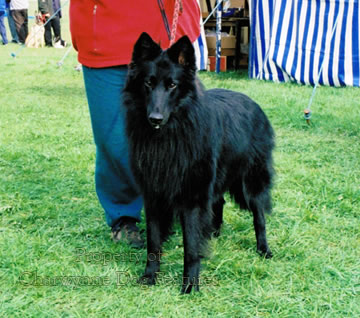 Pastoral Dog Need
Pastoral Dog Need
Up to 1000BC, something like four fifths of Europe north of the Alps and the Pyrenees was covered by dense forest. Over the next two hundred years, extensive clearance by farmers provided the basis for new growth through local trade, notably from the fairs dating from Charlemagne. This growth brought an unprecedented demand for herding dogs, both to control herds and get them to market. Bruges became the chief European wool manufacturing town and medieval Flanders and its neighbours produced a wide range of driving dogs, as the Bouvier breeds demonstrate. As increasing urbanization occurs in Europe, the pastoral breeds are vulnerable; yet, much further east, old breeds are being lost too. The Tooroochan Sheepdog of Siberia may now be lost as a distinct breed. Their past value has been forgotten. The need for guarding and moving sheep has lessened or been mechanized.
In the sixteenth century Spain had 3 million sheep and exported them both to her neighbours and to her new territories. The main trade was overland to France over the Pyrenees, with dogs playing a major role in their safe passage. In 1840, France had over 5 million sheep in her pastures. Two hundred and fifty years ago, the Danes were sending 80,000 head of cattle a year to Germany by driving them overland using dogs. The routes taken by the various drovers with their herding dogs crossed every European boundary and it would be unwise to claim purity of descent for the different national breeds of today. These European drovers used dogs like the Bouvier type and sharper quicker moving dogs like the herding breeds of Western Europe today.
Pastoral Breeds of the Low Countries
“The Groenedael and its kindred spirits, the Malinois and Tervueren, I could not find in work on any Belgian farms, and the trials I found were those for police type work. The intelligent traits of the Groenendael have been utilized by the police for their requirements, and in many countries the breed has been evolved for the show bench. This is the fate of many West European working dogs. Only once in the Black Forest of Germany have I seen an Alsatian, the German Shepherd Dog, in action with a flock of sheep.” Those words by Eric Halsall in his Sheepdogs – My Faithful Friends of 1980 tell a sad story of an ever-reducing need for the dogs of the pastures. But this neglect is not new, rooted not in human whim, but created by an increasingly urban landscape and as the livestock market changes its nature. The herding breeds may have suffered less than the flock guardians but having lived in Central Europe on three different occasions, been based in Gibraltar for a year, as well as attending half a dozen World Dog Shows all over Europe, I am very aware of the decline in use of the pastoral breeds and their drift to the show bench – or oblivion.
The Belgian Breeds
The herding breeds have been just as neglected abroad as in Britain. In Belgium, for example, their four varieties of shepherd dog, named after the region of their development: Tervueren, Groenendael, Malinois and Laekenois, were unrecognised and not bred to type until the invaluable work of Professor Reul of the Cureghem Veterinary School bore fruit at the end of the last century. It is claimed I know by the FCI and some national kennel clubs that the Bouvier des Flandres (or drover's dog of Flanders) is Belgian but the breed developed when Flanders, a medieval principality spanning what is now Holland, France and Belgium, was French, although there was once Spanish influence there too. There can be a distinct resemblance between the Bouvier des Flandres, the rough-haired variety of the Dutch Shepherd Dog and the Laekenois especially when all three were working types. Similarly, location has led to the Bouvier des Ardennes, a breed reminiscent of the Pumi of Hungary, another Belgian drover's dog, showing signs of French pastoral breeds, although, again, we must remember that the old Ardennes region occupied what is now parts of Belgium, Luxemburg and northern France. Working dogs do not relate to modern national boundaries, much more to routes to markets and grazing rights. Breeds are a modern phenomenon. 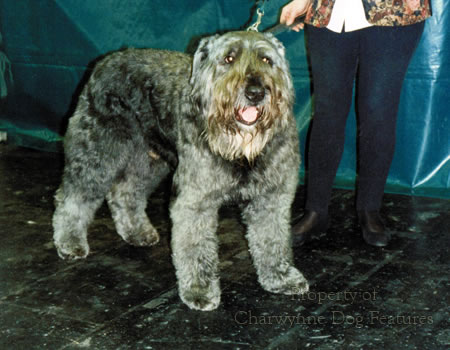
The Background to the Bouviers
Few breeds of dog developed in isolation from their function. Against this background, the Bouvier des Flandres became associated with the agricultural plain of Flanders and enjoyed a wide variety of names: vuilbaard (dirty beard), koe hund (cow dog) and toucheur de boeufs (cattle-mover or drover). When cattle and sheep were transported to market and ports by rail and truck, concern was expressed for the dogs of the local drovers, rugged handsome dogs conforming to an identifiable type. In 1910 the Bouvier was first exhibited as four varieties, the Bouvier de Roulers for example being bigger and black, but in 1912 the growing band of enthusiasts combined forces to standardize these into one. Then the Great War played havoc with the breeding stock and it was left to a Belgian Army veterinary surgeon, Captain Darby, who by saving some good specimens founded the modern breed through his sire Ch Nic de Sottegem. By 1922, the breed club had agreed the desired type and drafted a breed standard.
Since then, the Bouvier has become more a personal guard-dog, police or army dog than a pastoral breed but has remained essentially a working dog. The first American standard was approved in 1959, and revised in 1975 following the sensible Franco-Belgian agreement. With the breed type now agreed internationally, the Bouvier is gaining in strength in many widely-separated countries on sheer merit. I am more than a little puzzled though why the colour chocolate-brown should be so disliked and severely punished in the breed; if an otherwise good pup emerges in this colour, why consign it to the bucket? In Holland however they do favour a rough-haired shepherd dog, with a short or smoother-haired and a long-haired variety too.
The Dutch Breeds
Not surprisingly, there is a matching content to the pastoral breeds of Holland to those of Belgium: a shepherd dog with a number of varieties, originating in location but manifested in coat texture, but with the addition of their Beardie, the Schapendoes, no surviving Bouvier but an all-round farm dog, the Smoushond, that may have had the same role as Ireland’s Kerry Blue and Wheaten Terriers – all-round farm dogs, especially around the yard itself. The Dutch Shepherd Dog is little known in Britain but has three attractive variations: short-, long- and rough-coated, with the last-named having a distinct look of the Belgian Laekenois in some specimens and a hint of Bouvier in the larger ones. The Schapendoes has been covered in an earlier section, under the harsh-haired herding type found, each only slightly different, in half a dozen European countries.
The German Breeds
In Germany now, there is but one surviving breed of shepherd dog. Yet there were once distinct variations of it too: smooth-coated dogs; the white sheepdogs of Pomerania (the Pommerscher Hutehund, once tried by a Dorset farmer and shown at Crufts in 1919), the heavier-coated dogs of Bavaria and the south and the lighter-coloured dogs of Prussia. In the early days of this century, merle and wire-coated German Shepherd Dogs existed in the breed, with one well-known bitch of the 1920s, Lori Maier, featuring this coat texture, now no longer favoured. The Hutespitz, a big, thick-coated, white and fawn herding dog was once widely used in northern Germany. In the January 1884 edition of The Kennel Gazette there was a piece on German Sheepdogs that made some interesting observations: “Mr Beckmann in Der Hund thus describes the three types of dog found. ‘The rough-coated race has a hard coat with hardly any gloss, dry to the touch…the lower side of the tail becomes a stiff brush, the belly and hinder part of the legs are feathered. The colour is mostly a deep black or iron-grey…The colours alluded to above are occur in the rough-coated dogs also…In our country (Leipzig Saxony), on the Lower Rhine and about Westphalia these dogs are given the preference and we see them often in company with the numerous droves which are being weekly exported into France and Belgium…these rough-coated dogs come originally from the Hanoverian country.’” The writer went on to describe the other two types: the long-haired race, with a shaggy coat, parted along the spine, blue-grey in colour but also yellowish-white and the short or smooth-haired race, often docked and black and tan in colour – ‘come across here and there all over the country’. The accompanying sketch shows two of the types. 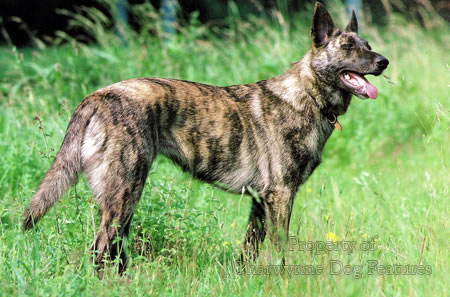
Working on three separate occasions in Westphalia and visiting the more remote farming areas, I never once found a German Shepherd Dog working with sheep but noticed golden-coated Hovawarts guarding the farmyards and, as ratting dogs, small pinschers being used, similar to the modern breeds of Miniature Pinscher and Schnauzer. The German breed of Schnauzer is a classic example of a versatile farm breed, the Riesenschnauzer or Giant Schnauzer was the drover and farm guard, the standard Schnauzer was the yard dog and the miniature version the ratter. On Irish farms I found the Wheaten and Kerry Blue Terriers being used as all-round farm dogs in exactly the same way, with the unclipped Wheatens closely resembling Bouviers and Schnauzers. The quaintly named sheep-poodle of Germany, that displayed a corded coat is probably now extinct, as is the old blue merle smooth-coated German Shepherd Dog, very much like our Smooth Collie.
French Farm Dogs
Only comparatively recently have we in Britain come to appreciate and then value the herding or herd-protecting breeds of France. But nowadays, with 12 Pyrenean Sheepdogs (rough-faced), 19 Beaucerons and 126 Briards registered with the Kennel Club in 2012 to reinforce the 105 Pyrenean Mountain Dogs, our acknowledgement of their many agreeable qualities is manifesting itself; all the French herding breeds resemble other European breeds too. The Berger de Brie or Briard is like the Schafpudel of Germany, the Berger de Beauce is similar to our own smooth collie, the Berger de Picardie resembles our long-lost Smithfield Sheepdog, the Berger des Pyrenees looks like the Schapendoes of Holland, the Catalan Sheepdog and our Bearded Collie, by type, as function and climate decided form. Lesser known varieties like the Berger des Pyrenees a face rasee or smooth-faced Pyrenean Sheepdog, the Berger du Langedoc or Farou, the Berger de Bresse, the Berger de Savoie and the Labrit from Les Landes in the south-west indicate the way in which the various areas can produce their own types, rather as the Galway Sheepdog, the Glenwherry Collie, the Welsh Hillman, the Black and Tan Collie and the Old Welsh Grey existed in the British Isles.
The French herding breed which impresses me the most in that country however is the Beauceron, a strapping handsome dog with the majesty of the Akita and the alertness of the Dobermann. (I strongly suspect that Herr Dobermann resorted to Beauceron blood in the creation of his breed). Black and tan or harlequin and sometimes dubbed 'bas rouge' or red stockings because of its red-tan legs, the Beauceron is little known outside France but is attracting interest both here and in the United States where a breed club has been formed and a stud-book opened. A big, robust, powerful, muscular but not heavy breed, 26" at the withers, very strong-minded and rather fierce in appearance, it is one of the few breeds whose strength of will you can sense and whilst it lacks the "strong eye" of our working sheepdogs, its work with cattle is in the brusque no-nonsense style. They have been used by both the French army and the police and my French friends tell me they were originally hunting dogs used on boar and stag, representing an ancient French type. The harlequin factor is found in hounds, as the Dunker hound, the Great Dane and the Dachshund illustrate; the "merling" of the Beauceron is more like the hound-colouration than that found in collies. French shepherds believed that double dew-claws on the hindlegs denoted herding skill in a dog; the Beauceron featuring this unusual addition today. The Farou or Berger du Languedoc, also called the Berger de Camargue and Chien de Larzac is probably a southern version of the Beauceron.
The Lost Breeds
The Labrit, probably getting its name from the town of that name in the south of France, (although some suggest it comes from de la Brie, since it is Briard-like and there was a tendency in the last century to call all French smooth-haired shepherd dogs chiens de Beauce and all coarse-haired dogs chiens de Brie) has now been embraced by the Pyrenean Sheepdog. The Berger de Bresse is almost certainly now lost to us and the Berger de Savoie, Beauceron-like but drop-eared, may too not have survived. Little is heard of the Picardie Sheepdog. We have probably lost more types of herding-dog all over Europe than of any other group; the pastoral scene has changed dramatically in this century and the advent of the pedigree dog has seen human whim play its part too. But this group of dogs have given man supremely loyal and devoted service over many centuries and whether French in origin or British deserve our gratitude. 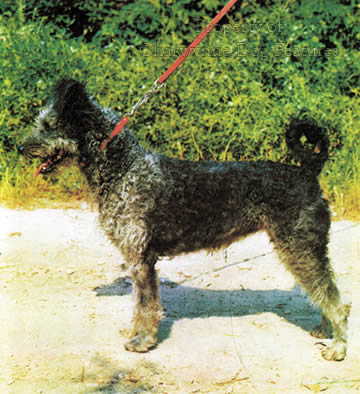
The Spanish Breeds
In further over, in Iberia, neglected or overlooked native breeds are becoming recognised as the canine heritage of each nation is at last being valued by the show fraternity; in Spain for example at the 2013 Madrid show, the Garafiano Sheepdog, from the Canaries, was paraded, then three other native breeds, the Carea Leones, from around Leon, sometimes called the Leonese Sheepdog or the Perro de Pastor Vasco, the Carea Castellano Manchego and the Euskal Artzain Txakurra, or Basque Shepherd Dog, were introduced to the curious onlookers in the main ring programme. The latter, surviving in northern Spain in the Bilbao region, now has its own preservation society/breed club and determinedly loyal fanciers. It is not unusual too to find the Australian Shepherd linked with Basque shepherds emigrating to Australia in the 19th century. The Catalan Sheepdog, or Gos D’Atura, is now becoming known in Britain, with 32 registered with the KC in 2012. The pastoral dogs of the Pyrenees, ranging from the huge mountain dog (on the French side) or Patou, the still-substantial Mastiff (on the Spanish side, also called the Mastin d’Aragon or the Navarro Mastiff) and the Beardie-like sheepdog or Gos D’Atura, have already been described. There is also the Majorca Sheepdog or Mallorquin Shepherd, a general farm dog , in two coats, short and long, and usually black.
It has been difficult for some time to research the Spanish pastoral breeds. I first read of them in Clifford Hubbard’s two books of the late 1940s: his The Observer’s Book of Dogs (Warne, 1947) and his Working Dogs of the World (Sidgwick & Jackson, of the same year). But he seemed unaware of the breeds referred to at the start of my previous paragraph. When living in Gibraltar for a year in the mid-1960s and camping in more remote parts of the Spanish hinterland, I found it difficult to identify their pastoral breeds as such. I saw Basque Shepherd Dogs, near San Sebastian, in red-tan or merle or harlequin coats, but also in two types, one for the higher pastures, the other for the lowland ones. I saw black merle Leonese Sheepdogs and black and buckskin Manchegos, with the huge Spanish Mastiffs much smaller in the high pastures than at shows or when used as guard dogs. Along the Portuguese/Spanish border, I found it hard to distinguish the Estrela Mountain Dogs from the Spanish Mastiffs used by shepherds in that region. But at the World Dog Show, held in Oporto, the breed differences were quite apparent. The shepherds seemed to care little about ‘unique type’ considered so precious by show
The Portuguese Breeds
The Portuguese pastoral breeds are as varied as, yet almost matching in type, those of neighbouring Spain, ranging from the Castro Laboreiro, the cattle dog of the north, the Estrela Mountain Dog from the central highlands – a classic flock guardian, the Rafeiro do Alentejo from the south and the Beardie-type, the Cao da Serra de Aires, a shaggy-coated sheep-herder. I have, when in Portugal and come across the last-named, thought at first it was a Catalan Sheepdog, so alike, to me, were the two breeds. And, on the same peninsula of Iberia, is this surprising? The Estrela is now well-established outside Portugal, with their registrations here sadly going down, year on year. The Rafeiro dog I have never seen outside Portugal, but been very impressed with them in their pasturelands. They may lack the eye-appeal of their more glamorous cousin from further north, but looked impressive, very serious about their work and probably a better watchdog. They have a wider range of coat colours and look much more like a working dog. The Castro Laboreiro can be remarkably Labrador-like, often displaying an otter tail; could they be linked, remembering the Portuguese presence off Eastern Canada in past centuries?
Eastern European Breeds
In Hungary, the distinctive Puli, Pumi and Mudi breeds still perform as movers of livestock, with the much larger Komondor and Kuvasz breeds acting as flock guardians. Only the Puli is seen in Britain's show rings in any numbers, but the Komondor and Kuvasz are recognised. In their Dogs of Hungary of 1977, Pal Sarkany and Imre Ocsag write: “It seems likely that the majority of the nine native recognized and registered breeds arrived in the Carpathian Basin during the Great Migration preceding the Magyars, the Huns and Avars, then with the Magyars and later on with the immigrating Pechenegs and Cumanians as their sheepdogs and hunting dogs…The Puli is the ancient sheep dog of Hungary. He has worked sheep on the plains of the Puszta since the 9th century, and has survived quite simply because he was, and still is, physically and temperamentally superlative for the work...Mudis are bred largely by shepherds and herdsmen…For a century the word ‘Pumi’ was confused with the word ‘Puli’. ‘Pumi’ may have been derived from ‘Puli’…the breed emerged about the 17th or 18th century…” More likely, when compared to the development of sheepdogs elsewhere, is that the Puli arose from longer-haired or corded ‘sports’ from the Pumi or Mudi, two breeds much more like each other, with the Pumi closely resembling the Labrit of the French Pyrenees. 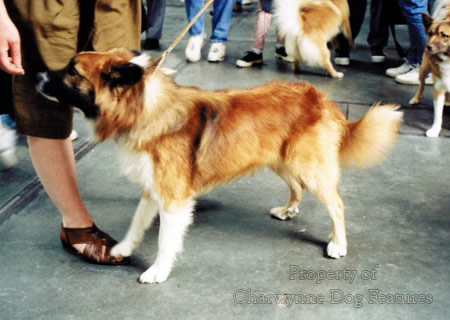
Breeds such as Roumania’s Mioritic Shepherd, the Bucovina Shepherd, the Carpathian Shepherd (once just called the Roumanian Shepherd and very similar to the Mioritic dog but heavier-headed) and the solid black, shiny-coated, well-named Raven Dog have been presented at their country’s shows for the first time. In Bulgaria, they have their Karakachan Dog, named after the Karakachan people, semi-nomadic livestock keepers and breeders. In Poland, their livestock protection dog is the Tatra Mountain Dog, resembling the Maremma in Italy, the Pyrenean Mountain Dog of France, the Kuvasz of Hungary and, especially, the Slovakian Shepherd Dog or Liptok. The Polish herder is their Lowland Sheepdog, now well known in Britain and covered in the section on the bearded types.
The Scandinavian Breeds
The Scandinavians still have their herding dogs, of the classic spitz type of the arctic north, and surprisingly similar in each country. When on an exploration trip to one of Iceland’s ice-caps, Hofsjokull, in the middle of the last century, I was intrigued to see what looked like a prick-eared, bushy-tailed collie on several farms there. Known locally as the Islandske Spidshunde and used to round up ponies as well as sheep, they have earned mentions both by Dr Caius and Shakespeare. The Icelandic Sheepdog is long-established and very collie-like, as is the Buhund or cattle dog of Norway, now becoming known in our show rings. The northern Scandinavian herding dogs range from the corgi-like to the collie-like, with the Norwegian Senjahund and the Swedish Vastgotaspets or Vallhund exemplifying the former and the maastehund of the Lofoten Islands, the Finnish, Swedish and Lapponian Herders resembling the latter. The corgi-type heelers like the Vallhund, have to be agile, quick and alert, if only to survive. As cattle dogs, as discussed in an earlier section, they have to learn to bite the hind foot that is bearing weight, giving them that extra split second to duck or flatten to avoid the reacting hefty kick. They learn too to attack alternate feet, rather than repeating the first attempt, just to gain a little more surprise. The Finnish Lapphund seems to be making progress here, although it was only recognized by the Finnish KC in the 1950s and separated from the smooth variety in 1967. This breed was introduced into Britain by Roger and Sue Dunger (Sulyka) and their enthusiasm has done much to promote this attractive breed here. Hardy, double-coated, working dogs, they have been bred by the Sami people of Lappland in Northern Scandinavia for centuries to herd their reindeer. I have watched in fascination similar dogs carrying out this task in Northern Norway, near Jaeggesvarre Glacier, when on an expedition there over half a century ago – a timeless scene. The herding breeds of Europe are truly special; I pray that the mistaken designs that some show ring breeders inflict on them soon get dismissed for what they are: valueless indulgences.